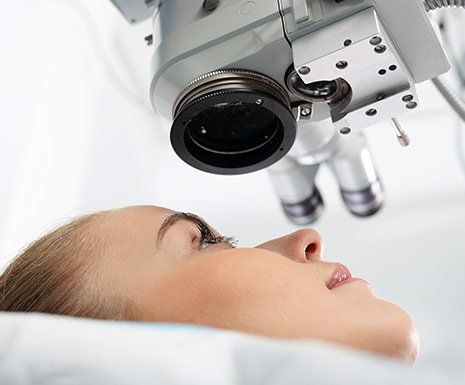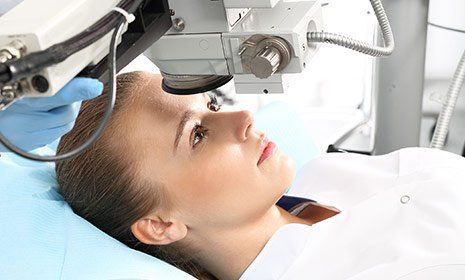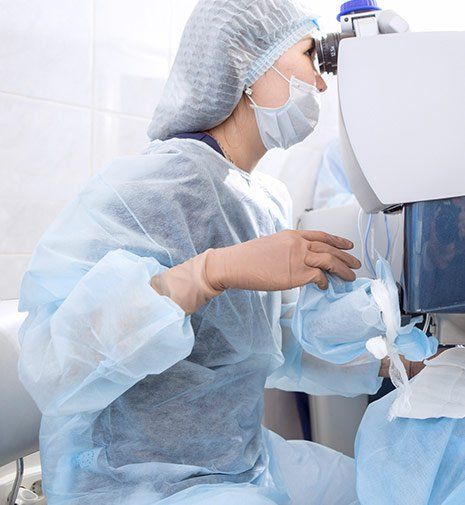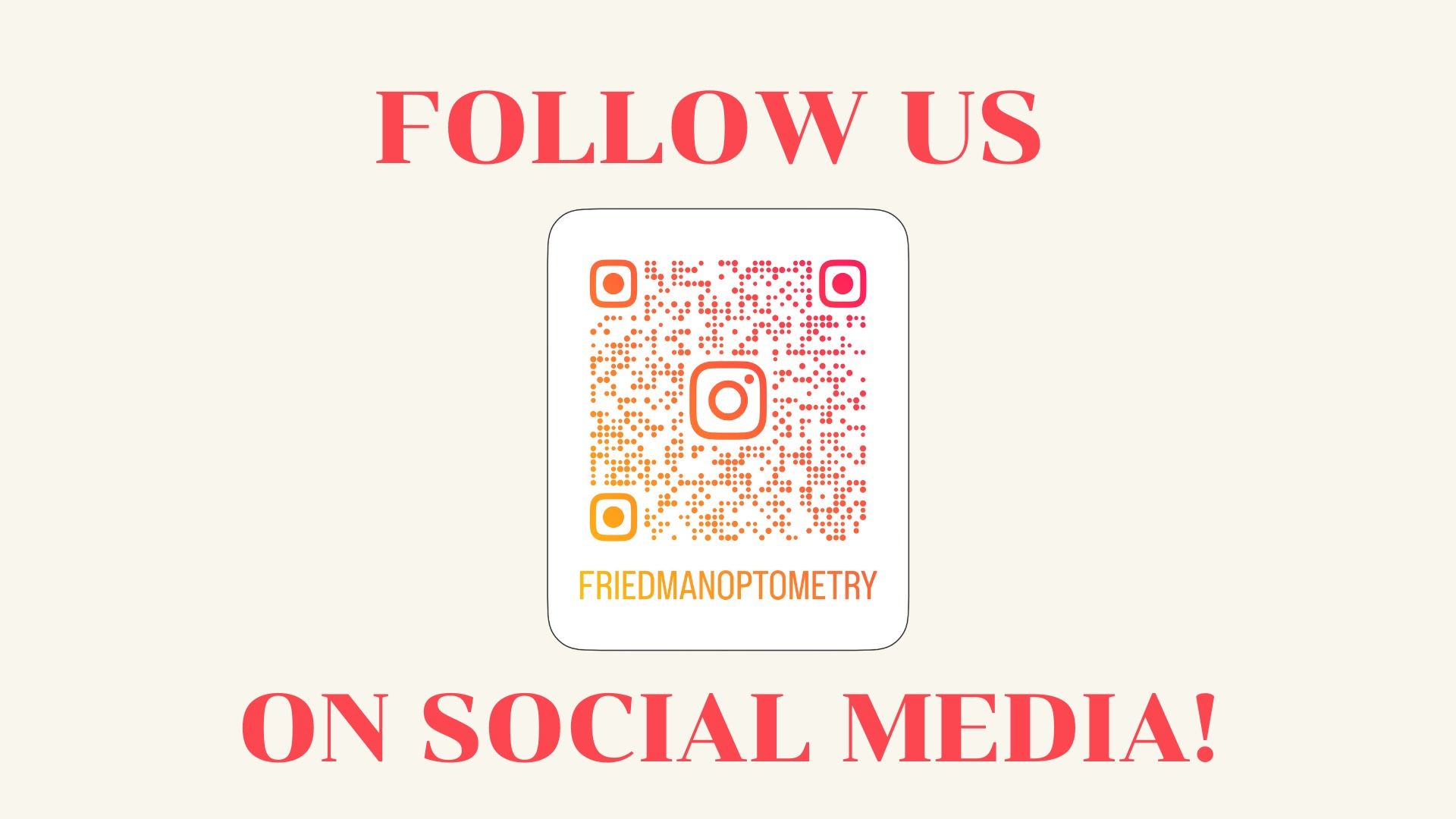LASIK Vision Correction – Complimentary Consultations Available
Wavefront Surgery provides CustomVue Wavefront-guided LASIK
The doctors at Friedman Optometry are associated with Berg-Feinfield Vision Correction Centers. We perform all eye exams, all procedure set-ups and all follow up care for LASIK Vision Correction performed at these centers. We also make all the arrangements for the procedure.
Nearly everyone has heard about the incredible LASIK procedure, and many may know a family member or friend who’s had it done. LASIK, or Laser In Situ Keratomileusis, is the most popular and most advanced way to trade in your glasses or contacts for clear, natural vision.
Contrary to popular belief, not all LASIK surgeons are alike. Although having the right technology is a big part of obtaining great LASIK results, a skilled surgeon who knows how to apply the laser and customize your treatment to fit your unique needs is essential.
An experienced LASIK surgeon will be better able to measure your refractive error accurately, and therefore be more likely to find your optimum vision correction results.
At Berg·Feinfield·TLC© Vision Correction, Dr. Berg combines many years of LASIK experience to give patients the benefit of carefully honed expertise. We offer the latest version of LASIK called CustomVue Wavefront-guided LASIK. With the use of a special Wavefront device, your unique eye abnormalities are identified and evaluated with a level of precision never before achieved.
Play sports, participate in hobbies, travel easier, and save money by reducing or eliminating your dependence on glasses and contacts! Although there is no guarantee that LASIK will give you perfect vision, choosing the right LASIK surgeon can ensure you get the best results possible.
LASIK – Frequently Asked Questions
Step 1
First, the surgeon applies a few numbing eye-drops to the eye prior to the procedure, and the surgeon marks the cornea with water-soluble ink to guide replacement of the flap.
Step 2
A thin corneal flap is created using an instrument called a microkeratome. This part of the procedure is called keratectomy and makes a "flap" in the corneal tissue on the central part of the eye, which is gently folded back, exposing the underlying layers of the cornea. This flap can also be created with the use of the Intralase laser.
Step 3
The surgeon then uses the excimer laser to apply a cool beam of light to gently even out the curvature of the cornea this is done with CustomVue Wavefront guided technology. The protective corneal flap is then gently placed back in its original position and begins healing immediately.
Step 4
After the flap is gently laid back, a few moisturizing drops are applied to soothe your eye and speed recovery. The cross-section view of the cornea shows the reduced (flatter) corneal curvature (exaggerated for clarity).
Dr. Alan Berg specializes in post Lasik complications. If you've had Lasik or other refractive surgeries with another surgeon and are experiencing complications, please contact us to schedule a comprehensive consultation.
Lasik Vision Correction
Alan M. Berg, M.D., a Board Certified Ophthalmologist, has been a pioneer in refractive surgery, beginning with Radial Keratotomy (RK), for the last 25 years. He now specializes in laser vision correction and refractive lens implant surgery. He chose to become an ophthalmologist "to help patients with their most important sense - their sight". Dr. Berg is a national consultant for Merck and Allergan medical corporations, enabling him to share his expertise in ophthalmology with ophthalmologists all over the world. Dr. Berg has performed over 20,000 LASIK procedures, including Dr. Feinfield, his partner. Dr. Berg has been chosen as one of only 50 surgeons in the U.S. to be involved with clinical trials of the Implantable Collamer Lens (ICL). Dr. Berg has chosen to use only state-of-the-art technology, to help his patients, which include both the VISX Star S4 with Custom Wavefront technology, and Intralase - alllaser technology.
Dr. Berg earned his medical degree and completed a year of residency at Bowman Gray School of Medicine in Winston-Salem, North Carolina. He finished his residency in Ophthalmology at the University of Southern California in Los Angeles, where he remains on the faculty teaching residents in training. He is a medical staff member and former Chief of Ophthalmology of Providence St. Joseph Medical Center. Dr. Berg is the former Chief of the Department of Ophthalmology at the City of Hope Medical Center in Duarte. He was an expert reviewer for the California Medical Review Board. He has performed thousands of cataract IOL surgeries and now utilizes advanced IOL technology including Multifocal/Accommodating Implants for the correction of presbyopia.
Dr. Berg was recently honored as VISX Star Surgeon by the VISX Laser company as one of the leading top 5% LASIK surgeons in the USA and has been featured on UPN (Channel 13) News regarding advances in LASIK technologies. Dr. Berg has been selected as one of the "Best Doctors in America" in 2005-06. He has lectured on laser vision correction throughout the United States to other ophthalmologists and has taught foreign ophthalmologists the art of LASIK. He is the medical director of Kobe Laser Center in Tokyo and Kobe, Japan.
When he is not working, he enjoys spending time with his wife and two children.
Are You a LASIK Candidate?
Once you’ve decided that you would like to have a LASIK procedure performed, the next step is to find out if you are in fact a good candidate for the procedure. Advancements in the development of LASIK have significantly widened the amount of patients who may benefit from this particular laser vision correction option. Thanks to the creation of the state-of-the-art VISX Star 4 laser and the Wavefrontguided CustomVue version of the LASIK procedure, patients with higher order aberrations can now successfully benefit from LASIK.
Despite the advances in LASIK, not everyone will make a perfect LASIK candidate. The laser vision correction offered at Berg·Feinfield·TLC© Vision Correction is an individual process, not a cookie cutter procedure. Your doctor will carefully evaluate your personal vision characteristics and eye history to determine whether or not LASIK can give you the vision results you’re looking for. Corneal shape and thickness and pupil size is measured, along with several other specialized tests. If, for instance, the presence of an eye disease or other complication increases your risks and decreases your chances for success during the procedure, Dr. Berg or Dr. Feinfield may recommend you consider other vision correction options.
Although it is impossible to determine whether or not LASIK can help you without a thorough eye evaluation, there are some guidelines
In general, good candidates for LASIK:
- Desire to correct low, moderate, or high levels of nearsightedness, farsightedness, or astigmatism
- Want clear vision without glasses or contacts
- Have had a stable prescription for at least a year
- Are not pregnant or nursing
- Are age 18 or older
- Have good overall health
- Have healthy corneas
- Have realistic expectations
- Are aware of the risks and possible complications
- Do not have an autoimmune disease or other major illness
- Are not currently taking medications that might slow healing
- Do not have severe dry eye syndrome
- How does LASIK work?
LASIK is "hybrid" procedure, combining the ALK technique with the accuracy of the Excimer Laser. First the doctor will use an instrument called a Hansatome Microkeratome or the Intralase laser to create a thin surface-flap under a microscope; this will only take a few seconds. Then the Excimer Laser, which has been pre-programmed with your exact correction, applies a rapid, cool ultraviolet light that precisely sculpts a very small amount of the sub-surface of the cornea. These short laser pulses correct the curvature of the cornea, allowing images to be focused clearly on the retina. The flap is then smoothed back down where it quickly bonds back in place, usually in three to five minutes, restoring a smooth, intact surface.
- Is the LASIK procedure approved by the FDA?
The FDA does not approve procedures; they approve the technology. They consider LASIK to be a "Practice of medicine issue," meaning that it is up to the doctor to decide what procedure is best suited for the patient. We use a laser that has been fully approved by the FDA, along with the Hansatome Microkeratome or Intralase laser. The laser used by our doctor represents the most advanced laser vision technology approved by the FDA.
- How long does LASIK take?
The actual procedure usually takes less than 15 minutes. Depending on your prescription, and the amount of correction needed, the laser itself only takes 20 - 50 seconds to correct your vision. However, you should plan to be in the office for approximately an hour and a half.
- Does LASIK hurt?
No. The treatment itself is painless. You will be given plenty of numbing (anesthetic) drops to completely numb the eye. You may feel a light pressure sensation around your eye, and after the procedure is finished you will feel a sensation our patients describe as "wearing a poor-fitting contact lens" for a few hours . . . but you shouldn't have any pain. We rarely find the need to prescribe anything for pain after the procedure - other than Tylenol.
- How long will it take to get my final LASIK results?
Although everyone is a little different, the vast majority of our LASIK patients achieve legal driving vision or better, the very next day. One of the most exciting advantages of the LASIK procedure; clear vision comes in quickly. The final result may take anywhere from a week to several weeks, but vision should improve gradually day by day.
- What side-effects can I expect from LASIK?
There are a few minor side effects associated with the LASIK procedure. Although post-operative pain is not commonly associated with the procedure (we don't need to prescribe anything other than Tylenol), some patients feel a "foreign-body sensation" for the first day or two. This is similar to the feeling of having a contact lens in the eye when you blink. Some patients may experience either "halos," glare, or light sensitivity around bright lights for a few days after the procedure. It may also take a short period of time to adjust to your close-up, or reading vision. Other, side effects include dryness, under/over correction, flap problems, long lasting halos and glare.
- Why can't you "knock me out" for the procedure?
Because, it's completely unnecessary. You'll realize just how unnecessary that would have been when you finally have your procedure done. Also, the risks associated with general anesthesia are excessive for a simple, pain-free procedure that only takes a few minutes. Also the procedure requires that the patient be alert to focus on a blinking light throughout the procedure.
- Can I drive myself home after the procedure?
No. You'll need to have someone drive you home after the procedure. Although your vision may (or may not) be good enough to drive after the procedure - everyone is different. The Valium we give you prior to the procedure is a mild sedative . . . and sedatives and driving don't mix.
- When can I go back to work?
You may go back to work the next day.
- Do you do both eyes at the same time?
We typically do both eyes at the same time with LASIK, although that decision should be made between you and the doctor. Since the vision comes in so quickly and the post-operative sensation is minimal, doing both eyes at the same time makes sense to most of our patients.
- Can children have this done?
No. The approximate minimum age-range for Laser Vision Correction is 18 to 21. That's because we require a "stable" prescription. Children are likely to have their prescription change over time, just like their shoe size and height change with time.
- Is there a maximum age . . . am I too old to have Laser Vision Correction?
Although there is no real "maximum age" for Laser Vision Correction, we would first need to determine that the overall health of your eyes is good, and that your vision difficulties are not being caused or hindered by cataracts.
Custom Lasik
What better way to improve your vision than with a completely customized LASIK procedure. Tailored to target your unique vision imperfections, the newest version of LASIK, CustomVue, is helping men and women all over the country.
So, what makes CustomVue different than traditional LASIK?
The 10% - 15% of the population that suffers from unique vision challenges, called higher order aberrations, are able to take advantage of a personalized laser treatment, whereas with traditional LASIK may not have been able to fix these vision problems. The laser is specially programmed to reshape your cornea based on distinctive corneal mapping information unique to each eye. If you’re nearsighted, farsighted, or astigmatic, CustomVue may offer you the chance to experience truly unique vision without glasses or contacts.
The CustomVue procedure utilizes Wavefront technology to measure and evaluate your vision system. With this state-of-the-art technology, your doctor is able to identify unique imperfections with 25 times more precision than traditional methods. After measuring at 200 various points, our equipment produces a detailed Wavefront map of your eyes, and uses this information to program your VISX Star 4 laser treatment. The accuracy allowed by this new method is unparalleled and offers patients with higher order aberrations the potential for perfect vision. With the developments used in CustomVue, many patients will end up with vision quality that surpasses the vision they experienced with glasses or contacts.
The CustomVue procedure also uses Iris Registration Technology, a non-contact alignment system that uses the information generated from the Wavefront map to successfully align your corneas for laser delivery. The accuracy offered by this technology is also unparalleled.
CustomVue is available for patients with:
- Myopia (nearsightedness)
- Myopia with astigmatism
- Hyperopia (farsightedness)
- Hyperopia with astigmatism
- Mixed astigmatism
Schedule your complimentary consultation today to find out if you are a good CustomVue candidate!
Browse Our Website
Business Hours
- Monday
- -
- Tuesday
- -
- Wednesday
- -
- Thursday
- -
- Friday
- -
- Saturday
- -
- Sunday
- Closed
Emergency Service 6 Days a Week
Browse Our Website
Contact Information
Phone: (310) 559-0500
Address: 10724 Washington Blvd., Culver City, CA 90232
Business Hours
- Monday
- -
- Tuesday
- -
- Wednesday
- -
- Thursday
- -
- Friday
- -
- Saturday
- -
- Sunday
- Closed
Emergency Service 6 Days a Week





